Fletch
I'll Lock Up
- Messages
- 8,865
- Location
- Iowa - The Land That Stuff Forgot
With interest growing in John Chapman's Good Wear Leather reproduction A-2s, I thought it was time I gave you my evaluation and photos of Good Wear's steerhide prototype of the Bronco ac29191 contract, which I acquired several weeks ago.
I should stress that I am not experienced with original A-2s, and that John intends his product to be extremely faithful copies of same. So I'll leave the authenticity evaluation to others. I also should note that although this is a very high quality garment, it is a test version. It should probably not be considered representative of a special-order Good Wear jacket in terms of fit, finish, or other such concerns.


click to enlarge these photos
Measurements for tag size 44:
back pit-pit 23 3/4" + front pit-pit 23 5/8" = chest 47 3/8"
shoulder 19"
epaulets 6 3/4"
sleeves 24 5/8" + 2 1/4" cuff = 26 3/4"
back length 23 3/8" + 3 1/4" waistband = 26 5/8"
armhole depth 10 1/4"
sleeve cross section at pit 8 7/8"; at cuff 5"
For reference, I am 5'10 1/2", 185 lb, with a 42" chest, 17" neck and 35" sleeve.
Materials and construction: The "Battle Cattle" steerhide is a tough yet amazingly soft leather with a rich caramel color palette and attractive variation in grain. John has evidently sealed the aniline dye with a non-water-resistant clearcoat that gives a moderate glossy finish. Its faint lacquer-like odor masks any natural leather aroma. This persists even after 3 hot soak, stretch and air dry sessions.

click to enlarge
John's care in workmanship and selection of materials is evident everywhere. Parts fit properly and are sewn firmly in place, but stitching isn't overly precise, which adds a one-off character. The all-cotton khaki thread is extremely strong, showing no signs of loosening or snapping despite repeated stress put on the armholes and side seams while soaking and stretching the leather. (I might add that the Battle Cattle is very resistant to stretching.)
The cotton lining again shows meticulous care. Light in weight, it is high-quality, finely-woven goods with wonderful body and a feel very like spun silk. It's nicely absorbent and quick-drying. The wool knit is slightly two-toned, with red-brown and dark brown tones in the yarn. It has a low gloss and a springy, resilient feel and isn't too warm or confining.
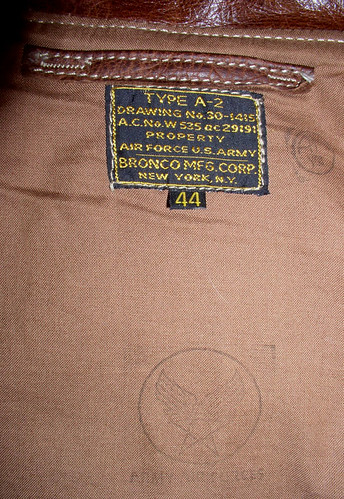
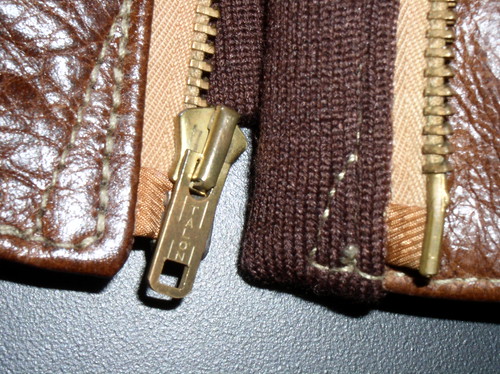
Wearability and fit: The Bronco fit is handsome, appears period correct, and is comfortable except for one difficulty. However, that one is critical. The jacket binds the upper arms and armpits tightly when they are lifted forward or upward. Many activities call for this: operating a vehicle, carrying large objects, or merely standing with arms folded. In my Bronco, doing any of these is uncomfortable.
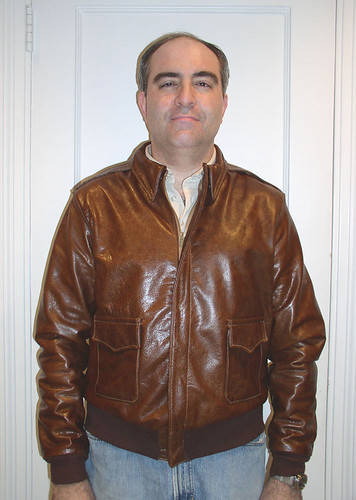
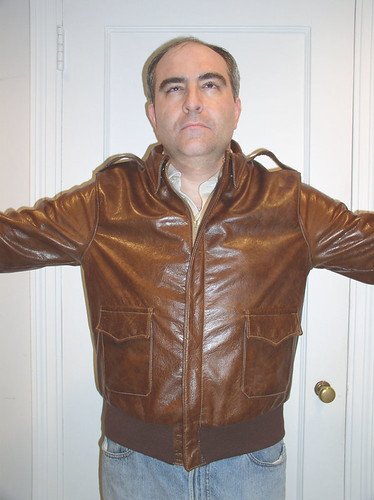
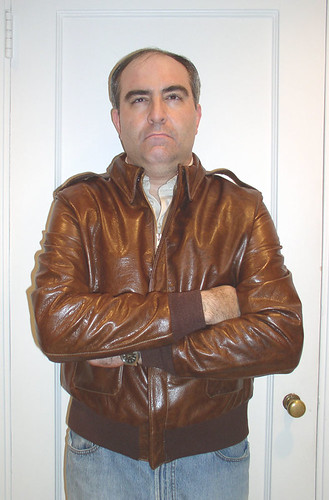
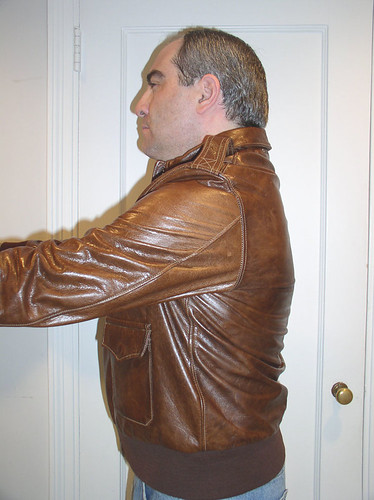
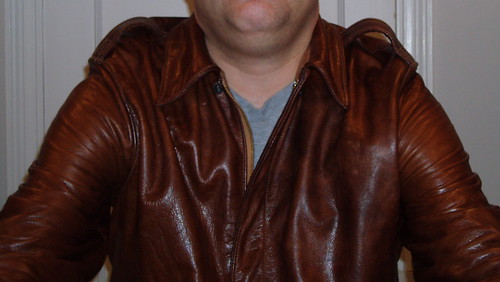
The sleeves are cut narrowly, even for my light upper body musculature. There is slack in the back panel only when my arms are at my sides. When the arms come forward, the back pulls taut and creases, the sleeves bind against the biceps, the cuffs tug up the wrists, and the extra material at the front armholes bunches up, further binding the arms. The shoulders and epaulets also lift and bunch. 3 attempts to hot-soak and stretch the jacket have changed it only very little.
I suspect part of the problem is that the Bronco's front and back armhole curves overlap exactly when it's laid flat. I compared it with 2 well-fitting A-2s I own, a Willis & Geiger horsehide in size 42, and an Aero "11018-P" Indian goatskin in size 44. (Neither is an exact contract copy, but both offer a fairly faithful period fit, except for the wide shoulders on the Aero.) On the Willis 42, the back curves are about 1" wide of the front curves on each side. On the Aero 44, the back curves are about 3/4" wide of the fronts. This seems to give enough slack for the arms to move forward. Neither jacket binds or restricts anywhere.
My conclusion: the Bronco binds because the pattern doesn't allow for many men whose backs are a bit broader than their chests, or whose shoulders naturally tilt a bit forward. If you're built like this, the Good Wear Bronco probably won't become your cherished second skin. However, it's an incredible piece of craftsmanship and a beautiful, quality garment. John Chapman really has something going here.
I should stress that I am not experienced with original A-2s, and that John intends his product to be extremely faithful copies of same. So I'll leave the authenticity evaluation to others. I also should note that although this is a very high quality garment, it is a test version. It should probably not be considered representative of a special-order Good Wear jacket in terms of fit, finish, or other such concerns.


click to enlarge these photos
Measurements for tag size 44:
back pit-pit 23 3/4" + front pit-pit 23 5/8" = chest 47 3/8"
shoulder 19"
epaulets 6 3/4"
sleeves 24 5/8" + 2 1/4" cuff = 26 3/4"
back length 23 3/8" + 3 1/4" waistband = 26 5/8"
armhole depth 10 1/4"
sleeve cross section at pit 8 7/8"; at cuff 5"
For reference, I am 5'10 1/2", 185 lb, with a 42" chest, 17" neck and 35" sleeve.
Materials and construction: The "Battle Cattle" steerhide is a tough yet amazingly soft leather with a rich caramel color palette and attractive variation in grain. John has evidently sealed the aniline dye with a non-water-resistant clearcoat that gives a moderate glossy finish. Its faint lacquer-like odor masks any natural leather aroma. This persists even after 3 hot soak, stretch and air dry sessions.

click to enlarge
John's care in workmanship and selection of materials is evident everywhere. Parts fit properly and are sewn firmly in place, but stitching isn't overly precise, which adds a one-off character. The all-cotton khaki thread is extremely strong, showing no signs of loosening or snapping despite repeated stress put on the armholes and side seams while soaking and stretching the leather. (I might add that the Battle Cattle is very resistant to stretching.)
The cotton lining again shows meticulous care. Light in weight, it is high-quality, finely-woven goods with wonderful body and a feel very like spun silk. It's nicely absorbent and quick-drying. The wool knit is slightly two-toned, with red-brown and dark brown tones in the yarn. It has a low gloss and a springy, resilient feel and isn't too warm or confining.


Wearability and fit: The Bronco fit is handsome, appears period correct, and is comfortable except for one difficulty. However, that one is critical. The jacket binds the upper arms and armpits tightly when they are lifted forward or upward. Many activities call for this: operating a vehicle, carrying large objects, or merely standing with arms folded. In my Bronco, doing any of these is uncomfortable.





The sleeves are cut narrowly, even for my light upper body musculature. There is slack in the back panel only when my arms are at my sides. When the arms come forward, the back pulls taut and creases, the sleeves bind against the biceps, the cuffs tug up the wrists, and the extra material at the front armholes bunches up, further binding the arms. The shoulders and epaulets also lift and bunch. 3 attempts to hot-soak and stretch the jacket have changed it only very little.
I suspect part of the problem is that the Bronco's front and back armhole curves overlap exactly when it's laid flat. I compared it with 2 well-fitting A-2s I own, a Willis & Geiger horsehide in size 42, and an Aero "11018-P" Indian goatskin in size 44. (Neither is an exact contract copy, but both offer a fairly faithful period fit, except for the wide shoulders on the Aero.) On the Willis 42, the back curves are about 1" wide of the front curves on each side. On the Aero 44, the back curves are about 3/4" wide of the fronts. This seems to give enough slack for the arms to move forward. Neither jacket binds or restricts anywhere.
My conclusion: the Bronco binds because the pattern doesn't allow for many men whose backs are a bit broader than their chests, or whose shoulders naturally tilt a bit forward. If you're built like this, the Good Wear Bronco probably won't become your cherished second skin. However, it's an incredible piece of craftsmanship and a beautiful, quality garment. John Chapman really has something going here.


